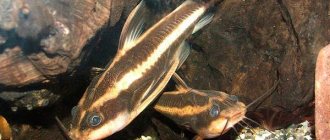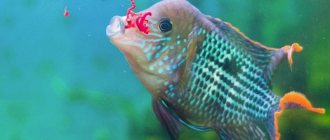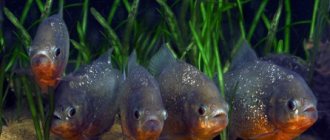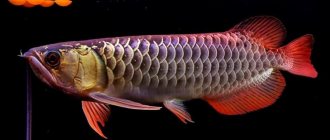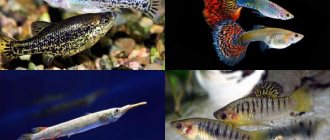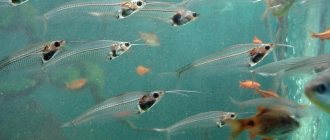The inhabitants of the sea differ according to various criteria: size, shape, family membership, and eating habits. The water world is so rich and diverse that it is difficult to imagine.
Not all marine inhabitants have been fully studied; in the depths of the sea there are individuals that people have not yet heard of.
Not all species are edible. Humanity values marine life so much as food that it has even learned to cook the poisonous puffer fish.
There are a lot of useful substances in it, but if the cooking process goes wrong and poison gets on the fillet, the person will face an unenviable fate.
Description and characteristics of marine fish
The seas occupy vast territories; temperature fluctuations occur here differently. This affects the lifestyle of marine inhabitants. At different depths, the characteristics of different fish species differ. The main differences from freshwater populations can be identified:
- For the inhabitants of rivers and lakes, differences in water temperatures are of great importance. For fish in the seas, the wind is a more important factor.
- Individuals living in salt waters are often massive and larger in size compared to freshwater species.
- Marine representatives are characterized by a more active lifestyle, therefore, when fishing at sea, the bite is more intense.
The wind creates waves, the fish feels the vibrations of the water masses. Under unfavorable weather conditions, schools may burrow into the sand, hide in rocks, or go deeper away from the shore. The inhabitants of the seas catch weather changes before people.
After a storm, experienced fishermen go hunting. During this period, fish emerge from hiding in search of food. Due to severe hunger, individuals bite on any bait.
Atlantic cod
Atlantic cod
Scientific name : Gadus morhua. Life expectancy : 25 years.
Atlantic cod, or simply cod, is one of the most consumed fish (by humans) in the world. They are found on either side of the North Atlantic Ocean, as well as parts of the Arctic Ocean, including the North Sea and the Baltic Sea.
The species can be recognized by the prominent white stripe that runs along its lateral line and dark spots on the upperparts. The average Atlantic cod is about 1.2 meters long and weighs 40 kg. However, the largest known cod fish in history weighed about 96 kg.
The Atlantic cod population declined sharply in the 1990s due to overfishing in the second half of the 20th century, and it has yet to fully recover.
Habitats
Fish populations inhabit all areas of the seas and oceans from southern latitudes to Antarctica. Shallow areas of the seas are most densely populated. Conditions for spawning and feeding are more favorable here.
The upper layers of water attract most species due to the abundance of oxygen and some due to their comfortable temperature.
Pelagic rocks (which do not sink to the bottom) prefer to stand in the middle and surface layers. Benthic representatives spend most of their lives near the surface of the bottom. Some species have the ability to move from the surface of the water to depths.
The quantitative indicator of populations depends on the chemical composition of the water. For example, bottom fish are rare in the Black Sea. At depths below 150 m, the water is saturated with hydrogen sulfide. Therefore, it is almost impossible to meet inhabitants beyond this mark. This feature is associated with the frequently asked question about what kind of fish is found in the Black Sea. Most of the species live here that feel comfortable at the surface of the water or in the middle layers.
The fish population of the White Sea is also not very diverse, as, for example, in the Barents Sea. This is due to the distance of the reservoir from the ocean.
Valuable fish species live in large numbers in the waters of the Pacific Ocean.
The further from the coast, the greater the diversity of species. Often individuals swim to the coastal zone, because there is more food here. Along the shore, small specimens and fry of large species like to scurry among the thickets. They are often found among shells and rocks.
Sometimes fish carcasses are washed ashore by the tide. For example, flounder is often collected this way.
The location of the schools depends on sea currents. In this regard, marine rocks are divided into 2 groups:
- Cold-loving. The group has another name - Arctic. Individuals drift along cold currents. They prefer to live at depths where the water does not heat up. They often live in the seas of northern latitudes.
- Heat-loving. They are also called tropical. These representatives prefer to move along warm currents and are often found in shallow waters.
If caught in an inappropriate current, the fish may die. Often schools are driven into bays by dolphins. Therefore, in such places even fishing from the shore is effective.
Basa
Pangasius or Basa
Scientific name : Pangasius bocourti
Basa is a widely consumed (by humans) fish species found primarily in mainland Southeast Asia. Regionally, the species is known by different names. In the UK they are commonly known as "river cobbler", while in Australia they are called basa fish or swayfish.
Environmental research organizations such as OceanWise, part of the Vancouver Aquarium, have raised concerns about Bas's potential negative impact on the environment.
Varieties
Many species are commercially available and are divided into families. Names of sea fish:
- perch;
- horse mackerel;
- sturgeon;
- scorpionfish;
- steam;
- croakers;
- salmon;
- herrings;
- nototheniaceae;
- cod;
- flounder.
There are others, such as the shark family. Some species of marine representatives are classified as elite breeds, while a number of others are caught in most port cities in industrial quantities.
cod
Representatives of this group are more than 100 species of fish. Of the cod family, only burbot is able to live in fresh water.
This group prefers cold water, so it is most often found in the Atlantic Ocean and in the seas of the Northern Hemisphere. Most individuals prefer to move in small groups. They are distinguished by a developed caudal fin and the presence of two dorsal fins. The cod family includes:
- cod;
- burbot;
- haddock;
- Pacific pollock;
- navaga.
Cod species, which feed on plankton, are small marine fish. Individuals that prefer larger marine inhabitants as food are distinguished by their large dimensions.
Cod
Mackerel family
Representatives of mackerel prefer a pelagic lifestyle, that is, they do not sink to the bottom. Their body structure allows them to be good swimmers and move quickly through the water.
Examples of family members:
- mackerel;
- tuna;
- bonito.
This group inhabits the seas of temperate, subtropical and tropical latitudes.
Mackerel
Flounder
The body shape of flounders is often oval or diamond-shaped. These species live along the bottom surface. Some of them prefer shallow water, while a number of others like to stand in the depths.
The group includes:
- flounder;
- halibut;
- Kalkan;
- sole.
Flounders are found along the entire coast of Eurasia and in the seas within the continent.
Flounder
Herrings
Representatives of this group are distinguished by the absence of scales on their heads. They are the most important commercial fish. The family includes:
- herring;
- belly;
- herring;
- anchovy;
- sprat;
- European sardine.
More often found in northern latitudes.
gold fish
Goldfish
Scientific name : Carassius auratus
Goldfish are perhaps the most common aquarium fish in the world. If you have or have ever owned an aquarium, there is a good chance that you keep a goldfish as a pet.
Based on body characteristics and coloration, goldfish can be divided into 300 varieties. Most known varieties of goldfish come from China, where they were first developed about 1,000 years ago.
Carassius auratus is also one of the best studied freshwater fish species. Numerous studies have shown that goldfish have powerful cognitive and learning abilities. In one such study, researchers found that goldfish can differentiate between different colors and shapes. They also have a memory period of three months.
Formidable sea predators
Predators include fish that feed on other marine life, birds, and sometimes some animals. The sizes of individuals can range from small aquarium specimens to those with impressive dimensions. All predators have in common the presence of sharp teeth.
The vast majority live in tropical and subtropical latitudes.
Predatory marine fish that pose a danger not only to neighboring populations, but also to humans:
- Shark. It is the largest predator. The most dangerous is the white shark, the safest is the whale shark. This is a sea fish with keen eyesight; it detects water fluctuations 200 m away. It is found in all water areas; the Black and Caspian seas are considered the safest. In the Black Sea there is a small shark, the Black Sea katran. Cold-resistant sharks live in the White Sea and are also found in the Barents Sea. They do not pose a danger to humans.
- Moray eel. Lives in underwater caves, coral reefs and thickets. Has a strong lightning-fast grip.
- Barracuda. Outwardly it resembles a giant pike, the size can reach 3 m. It is called a sea tiger for the presence of sharp teeth and a sudden grip. It feeds on any food, even if the prey is poisonous. Therefore, the meat of this fish can be dangerous to eat.
- Swordfish. It looks like a torpedo in appearance, and the sword-shaped appendage can reach 1.5 m. The impact force is 4 tons. Individuals develop rapid speed, which surprises ichthyologists. Even sharks are eaten.
- Angler. Lives on the bottom surface. The long fin is used as a fishing rod. Bacteria living on the process serve as bait for other fish. Periodically rises to the surface to catch birds.
There are predatory species that are not dangerous to humans. For example, among the commercial species, tuna is a schooling predator. It feeds on sardines, mackerel, crustaceans and other living creatures. Also distinguished by their predatory lifestyle are:
- bonito;
- flounder;
- bluefish;
- catfish;
- pink salmon;
- Atlantic and Pacific cod;
- croaker;
- laurel;
- rock bass;
- sea ruff
Predators are important to the balance of nature.
Nile tilapia
Nile tilapia
Scientific name : Oreochromis niloticus
Nile tilapia is one of the most important fish in the world. The species is native to northern Africa, although populations of Nile tilapia have been introduced to other parts of the world. Nile tilapia averages about 60 cm in length and rarely exceeds 5 kg in weight.
From various paintings it is clear that this species was well known to the ancient Egyptians. One such illustration was found on an ancient Egyptian tomb depicting a fish, most likely a tilapia, in an artificial pond.
Nile tilapia are very social. They even exhibit a social hierarchy where males are more dominant and usually have control over mating and eating.
Alphabetical list
Shark Albula Anchovy Aprio Argus Mullet Barracuda Berix Bonefish Splasher Bulleye Goby Variola Wahoo Garrupa Croaker Grouper Wrasse Jacas Jack Fish Job Fish Dorado Stargazer Zebrosoma Carang Caranx Crucian carp sea. Mullet King Fish Stickleback Coryphaena Crevalle Lionfish Letrin Flying Bluefish Snapper Mackerel Manta Marlin Mahi Mahi Merluza Capelin Pipefish Angelfish Seahorse Sea Bream Moray Sailfish Pelamid Permit Haddock Platax Pompano Red Snapper Angelfish Butterflyfish Zebrafish Hammerfish Napoleon Rhinoceros Fish Sawfish Parrotfish Slingfish Surgeonfish Sabretooth Pollock Sargan Sardine Herring Seabass Sigan Stingray Mackerel Snapper Snook Blenny Mackerel Tarpon Trachinote Cod Tuna Eel Hake Chimera
Trout
Trout
Family : Salmonidae
Trout is a common name used to refer to a large number of species of freshwater fish belonging to three different genera; namely Salmo and Salvelinus, and Oncorhynchus.
Trout patterns and coloring can vary depending on their immediate surroundings, and many of its species exhibit intense coloration when they are about to spawn. With a few exceptions, all trout species are morphologically distinct from each other but show no evidence of major genetic differences.
Lake trout, widespread in North America, can weigh more than 30 kg.
Useful properties of sea fish
The composition of sea fish meat, rich in protein and polyunsaturated fats, allows it to be included in the diet menu. Main advantages:
- Marine fillets contain fewer bones.
- Parasites are less common in marine rocks.
- Marine species are considered more healthy and are distinguished by their fat content. Fillet contains a large amount of useful substances, including omega-3 and omega-6 acids, vitamins and iodine. Eating it saturates the body with phosphorus, bromine, potassium, iron, zinc and other useful microelements.
The beneficial composition of marine fish fillets has a beneficial effect on the functioning of the cardiovascular system and improves immunity. Has a positive effect on brain activity.
Salmon varieties are considered especially valuable, but other types of sea fish are not inferior in their beneficial properties:
- Representatives of the cod family are dietary species, the fat content is about 2%.
- Species of the flounder family contain a minimum of bones, and the fillet is rich in vitamin complex.
- Meat from the mackerel group is tender and low in fat.
- Representatives of croakers resemble river fish in taste.
- The horse mackerel group is characterized by a slightly sour taste. Fat content is no more than 5%.
- Scorpionaceae, sparovaceae and notothenia species are classified as fatty varieties.
Fish protein is well absorbed by the human body. Doctors recommend including fish in your diet at least three times a week. Regular consumption helps regulate blood cholesterol levels and maintain thyroid function.
Neon tetra
Neon tetra
Scientific name : Paracheirodon innesi Lifespan : 5-10 years
The neon tetra is a popular aquarium fish known for its vibrant color patterns. They are native to the clear and black waters of the Amazon, but are also available in various Southeast Asian countries where they are farmed. The maximum length of a neon tetra is about 3.5 cm.
The species can be easily identified by the two iridescent horizontal stripes on each side. The first is a shiny blue stripe extending from the eye to the adipose fin. The second is a thick red stripe that starts from the middle of the body and ends near the back of its tail. These iridescent stripes turn dull or gray at night.
Distinctive features
All stingrays differ from each other, firstly, in size. In nature, fish are known to be only a couple of centimeters long, and stingrays whose size reaches seven meters. In addition, the behavior of each species is completely different. Some of them do not mind jumping above the surface of the water, while others prefer to bury themselves in the sand and rest quietly.
Stingray fish is a predatory animal whose main food is the following marine inhabitants:
salmon; sardines; capelin; octopuses; crabs.
Stingrays are so diverse that even in hunting, everyone uses different weapons - what nature has awarded them. The electric one, having caught up with the prey, wraps its fins around it and delivers an electric shock, expecting its death. And the prickly tail kills the victim with the help of its tail, studded with thorns, which it thrusts into the enemy. To eat mollusks and crustaceans, they resort to protruding plates that replace their teeth, and they also use them to grind their food. As for reproduction, some of the species are viviparous, while others lay eggs in special natural capsules.
Pelamida
The body shape resembles tuna, only proportionally reduced. This predatory schooling fish lives in the Black Sea, reaches a weight of seven kilograms and a length of eighty-five centimeters. Pelamids, like tuna, are heat-loving, so they go to the Sea of Marmara for the winter, while the schools return to the Black Sea waters already quite thinned out, so it is rarely possible to catch such an individual. There are many types of bonito: king mackerel (wahoo), one-colored bonito, sawara, spotted bonito and others. The meat of these fish has a light color, dense consistency and pleasant aroma, contains from two to five percent fat (with the exception of bonito, which has a fat content of up to twenty percent).
